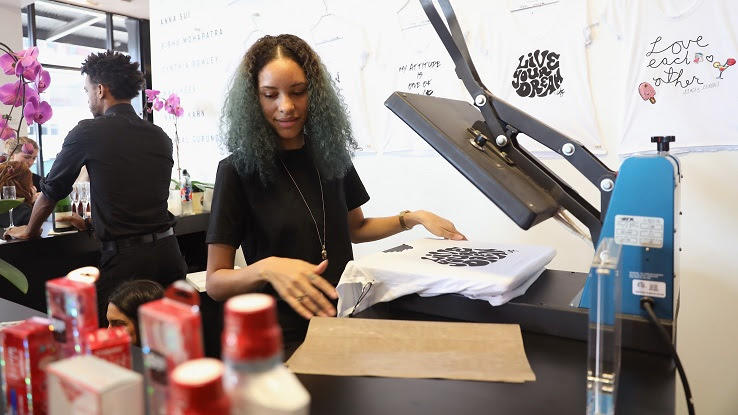Making T-Shirts? Here’s the Science Behind the Sublimation Print Process

Have you ever wondered what goes into the printing of your favorite graphic tees? When it comes to shirt printing, sublimation and heat-transfer are two of the most popular methods.
These styles each have a unique science behind the way that they bind a design to fabric. So, what is the process behind shirt printing? And how can you make your own shirts at home? We’re exploring both topics — and more — here.
What Is Sublimation Printing?
Sublimation is a unique printing method that creates a vibrant, long-lasting image on a garment. Sublimation printing is often used for clothing like graphic-tees, jerseys, band shirts, and high-quality tee-shirt prints found in stores. Your favorite piece of merch from a concert? Your school sports jersey? Your shirt from a local charity run? All of the images and lettering on these garments were likely created using sublimation printing or a similar printing method.

Sublimation is unique to other printing styles in that it creates a stronger bond between the design and the fabric, ensuring a semi-permanent quality to the print. Compared to other printing styles, sublimation holds up better across time and doesn’t fade or lose texture in the same way that other printing methods might.
Most printing companies will perform sublimation printing for some or all of their products. These garments will likely come at a slightly higher price tag compared to other methods, such as heat transfers, due to their ability to endure wear and tear. For a piece of clothing that will be well-loved and worn for months or years to come, sublimation is the ideal method.
How Does Sublimation Work?
Special supplies are needed in order for sublimation printing to work. First, designers must use a sublimation-compatible printer and sublimation ink, which allows for a design to be printed on sublimation paper. Sublimation paper absorbs the ink put out by the printer, and, then, once heat is applied, releases the ink through pores in the paper onto whatever surface will feature the design.

A heat press is also needed for sublimation printing, as well as an understanding of what surfaces or clothing types do and do not respond well to sublimation. In garments, sublimation can only be used on polyester; you can’t use this method for cotton, wool, or silk. While you can print on certain non-clothing objects, such as coffee mugs, not every type of surface is porous enough to react positively to sublimation printing.
In application, sublimation printing is a simple process. The first step of sublimation printing is to choose your design. You will need to print the graphic out onto sublimation paper using a sublimation printer. You can then apply the design by placing the sublimation paper onto the surface of the garment. Next, use a heat press that releases the ink from the paper’s pores and turns it from a solid into a gaseous form. The ink then transfers onto the garment, and, once the paper is cooled and removed, the design will remain on that piece of clothing.
How Does It Compare to Heat Transferring?
While sublimation printing is the more popular option for larger batches of clothing, heat transferring is more common for low-budget and/or personal projects. This is due, in part, to the lower cost of supplies and the lack of expertise required.
For heat transferring, the design to be applied to the garment is printed onto heat transfer paper, a sensitive type of paper that binds an image to fabric. Using a press, the print will then be pressurized onto the shirt, leaving behind that design once the heat transfer paper is removed.

Heat transfers are easier to perform, and are cheaper, yet they have some downsides. They don’t hold up as well over time as garments that are created using sublimation printing. With each wash, prints on the front of these garments will gradually wear down and de-color. These shirts can also lose their original texture over time, becoming flaky or tough in your dryer cycle. However, as the more affordable and accessible option, heat printing can be the better choice for personal projects or a limited run of clothing.
How Can You Print Shirts at Home?
If you want to print shirts at home, but don’t have a heavy-duty sublimation printer or a heat press, there are still ways you can make your own garments. The most popular D.I.Y. printing method combines the power of a printer and a clothing iron.

For good results, you’ll want to make sure the iron is empty of water and set to its steam and cotton settings. For starters, you’ll need to use an Inkjet printer and fabric transfer paper when printing your design. First, print the image inverted/mirrored onto the transfer paper, and then place it onto the front of your shirt. Next, iron the design on until the heat releases the image onto the clothing. If you don’t have an Inkjet printer, you can buy pre-printed designs that have been copied onto heat transfer paper at many craft stores, as well as online.
Where Can You Get Shirts Professionally Printed?
In addition to home-crafting, there are a ton of popular printing companies that will allow you to professionally print your designs. One of the most popular printing companies is CustomInk, which allows you to print and order shirts, sweatshirts, hat mugs, and more across a wide range of fabrics and materials. Since this company sells items largely in-bulk, this is a good choice for printing group items, such as shirts for charity runs, fundraisers, school clubs, sports teams, or family reunions.

If you’re an artist or a designer, some sites allow you to upload your designs and have them printed on-demand for online consumers. Redbubble allows you to boost the visibility your designs on their platform and have them custom printed onto a variety of products, including pillows, shirts, bedspreads, and blankets. Shopify is similar, allowing you to upload your work to the products of your choice, then placing them into an online marketplace for sale. If you’re looking to launch your artwork and find an audience, these companies can help customers find your designs.





